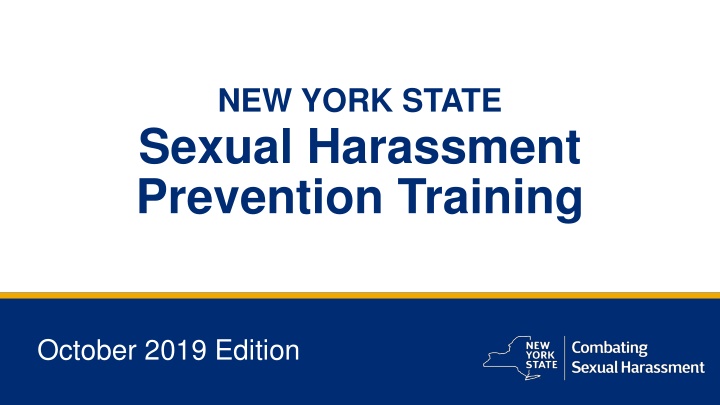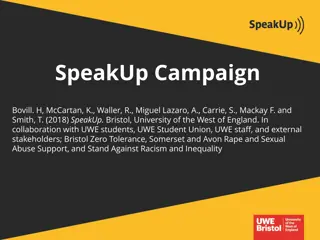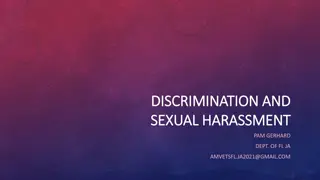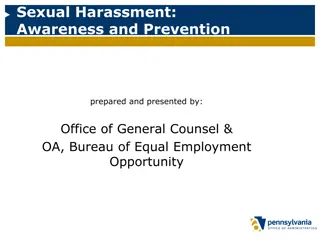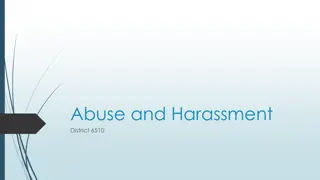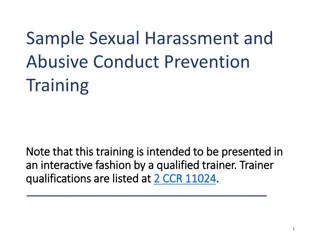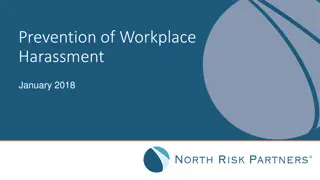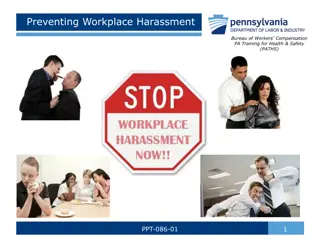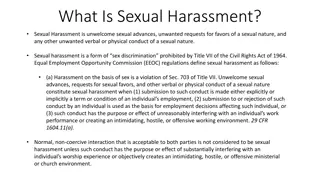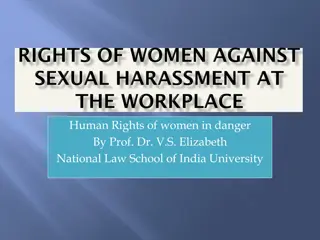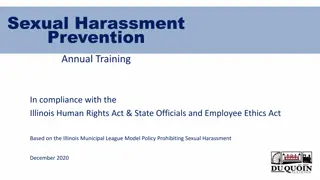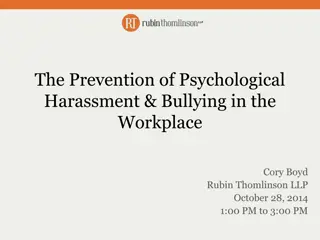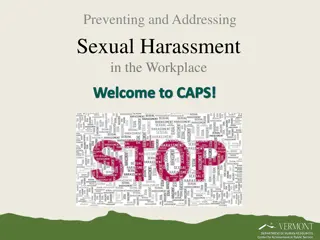New York State Sexual Harassment Prevention Training Overview
This material provides insights into the October 2019 edition of the New York State Sexual Harassment Prevention Training. It covers topics such as sexual harassment in the workplace, what constitutes sexual harassment, and the implications under New York State law. The training aims to enhance understanding, reporting procedures, and external reporting options related to sexual harassment. Various scenarios and definitions are discussed to promote a harassment-free work environment.
Download Presentation

Please find below an Image/Link to download the presentation.
The content on the website is provided AS IS for your information and personal use only. It may not be sold, licensed, or shared on other websites without obtaining consent from the author.If you encounter any issues during the download, it is possible that the publisher has removed the file from their server.
You are allowed to download the files provided on this website for personal or commercial use, subject to the condition that they are used lawfully. All files are the property of their respective owners.
The content on the website is provided AS IS for your information and personal use only. It may not be sold, licensed, or shared on other websites without obtaining consent from the author.
E N D
Presentation Transcript
NEW YORK STATE Sexual Harassment Prevention Training October 2019 Edition
2 Introduction
3 Sexual Harassment in the Workplace
4 Sexual Harassment in the Workplace Sexual harassment will not be tolerated. Today s training will: Help you better understand what is considered sexual harassment Show you how to report sexual harassment Show you external reporting options
5 What is Sexual Harassment? Sexual harassment: Is a form of sex discrimination and is unlawful Includes harassment on the basis of sex, sexual orientation, self-identified or perceived sex, gender expression, gender identity and the status of being transgender. Is unlawful when it subjects an individual to inferior terms, conditions, or privileges of employment.
6 What is Sexual Harassment? It includes unwelcome conduct, either of a sexual nature or which is directed at an individual because of that individual s sex when: Such conduct has the purpose or effect of unreasonably interfering with an individual s work performance or creating an intimidating, hostile or offensive work environment; Such conduct is made either explicitly or implicitly a term or condition of employment; or Submission to or rejection of such conduct is used as the basis for employment decisions.
7 What is Sexual Harassment? Under New York State law, harassment need not be severe or pervasive to be unlawful. Any of the harassing conduct described in this training can be unlawful unless it is shown to be no more than petty slights or trivial inconveniences.
8 Hostile Environment Sexual or discriminatory displays or publications anywhere in the workplace Hostile actions taken against an individual because of that individual s sex
9 Quid Pro Quo Sexual Harassment Occurs when a person in authority trades, or tries to trade, job benefits for sexual favors. Occurs between an employee and someone with authority, who has the ability to grant or withhold job benefits.
10 Who can be the Target? Sexual harassment can occur between any individuals, regardless of their sex or gender. The law protects employees, paid or unpaid interns, and non-employees who work in the workplace.
11 Who can be the Perpetrator? Anyone in the workplace: A coworker A supervisor or manager Any third-party (non-employee, intern, vendor, customer, etc.)
12 Where Can Workplace Sexual Harassment Occur? Whenever and wherever employees are fulfilling their work responsibilities, including: Employer-sponsored events Conferences Office parties Off-site or during non-work hours
13 Sex Stereotyping Harassing a person because that person does not conform to gender stereotypes is sexual harassment. Harassment because someone is performing a job that is usually or was previously performed mostly by persons of a different sex is sex discrimination.
14 Retaliation
15 Protected Activities Any employee engaged in protected activity is protected by law from being retaliated against. Protected activities include: Making a complaint about harassment or suspected harassment Providing information during an investigation Testifying in connection with complaint
16 What is Retaliation? Any action to alter an employee s terms and conditions of employment because that individual engaged in protected activities. Examples: Sudden change in work schedule or work location Demotion
17 What is Not Retaliation A negative employment action is not retaliatory merely because it occurs after the employee engages in protected activity.
18 Supervisor s Responsibility
19 The Supervisor's Responsibility Supervisors and managers are held to a high standard of behavior. They are: Required to report any harassment reported to them or which they observe. Responsible for any harassment or discrimination they should have known about. Expected to model appropriate behavior.
20 Mandatory Reporting Supervisors must report any harassment that they observe or know of, even if no one is objecting to it. Harassment must be promptly reported to the employer. Supervisors and managers will be subject to discipline for failing to report suspected sexual harassment. Supervisors and managers will also be subject to discipline for engaging in retaliation.
21 What Should I Do If I Am Harassed?
22 What Should I Do If I Am Harassed? We will provide you with a complaint form to report harassment and file complaints. Submit it to: [Person or office designated] [Contact information for designee or office] [How the Complaint Form can be submitted] You may also make reports verbally.
23 What Should I Do If I Witness Sexual Harassment? Anyone who witnesses or becomes aware of potential instances of sexual harassment should report it to a supervisor, manager or designee. It is unlawful for an employer to retaliate against you for reporting suspected sexual harassment or assisting in any investigation.
24 Investigation and Corrective Action Anyone who engages in sexual harassment or retaliation will be subject to remedial and/or disciplinary action. An investigation of any complaint should be commenced immediately and completed as soon as possible. The investigation will be kept confidential to the extent possible. Any employee may be required to cooperate as needed in an investigation.
25 Investigation Process [Person or office designated] will conduct an immediate review of the allegations, and take any interim actions Relevant documents, emails or phone records will be requested, preserved and obtained. Interviews will be conducted The individual who complained and the individual(s) accused of sexual harassment are notified of final determination and that appropriate administrative action has been taken.
26 Additional Protections and Remedies
27 NYS Division of Human Rights (DHR) A complaint alleging violation of the Human Rights Law may be filed either with DHR or in NYS Supreme Court. Complaints may be filed with DHR any time within one year of the alleged sexual harassment. You do not need to have an attorney to file. More information: www.DHR.ny.gov
28 United States Equal Employment Opportunity Commission (EEOC) An individual can file a complaint with the EEOC anytime within 300 days from the alleged sexual harassment. You do not need to have an attorney to file. A complaint must be filed with the EEOC before you can file in federal court. More information: www.EEOC.gov.
29 Local Protections Many localities enforce laws protecting individuals from sexual harassment and discrimination. Contact your county, city or town to find out if laws exist. Harassment may constitute a crime if it involves things like physical touching, coerced physical confinement or coerced sex acts. Contact the local police department.
30 Summary
31 Other Types of Workplace Harassment Any harassment or discrimination based on a protected characteristic is prohibited in the workplace and may lead to disciplinary action against the perpetrator. Age, race, creed, color, national origin, sexual orientation, military status, sex, disability, marital status, domestic violence victim status, gender identity or expression, familial status, predisposing genetic characteristics and criminal history. Much of the information presented in this training applies to all types of workplace harassment.
32 Summary How to recognize harassment as inappropriate behavior. Harassment because of any protected characteristic is prohibited. Why workplace harassment is employment discrimination. All harassment should be reported. Supervisors and managers have a special responsibility to report harassment.
33 Important Resources Find the Complaint Form: [insert information here] For additional information, visit: www.ny.gov/programs/combating-sexual-harassment-workplace
